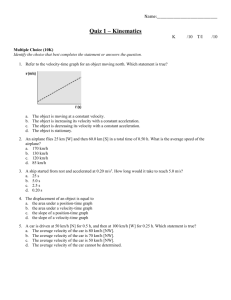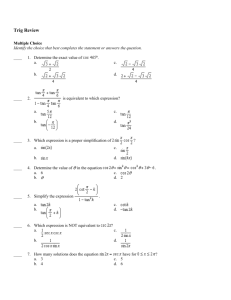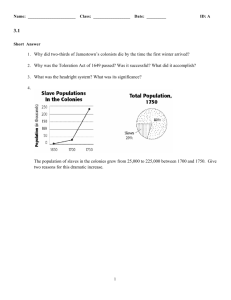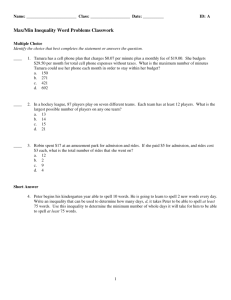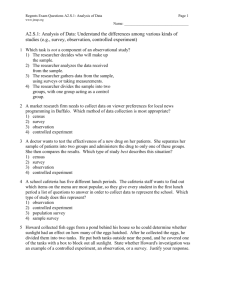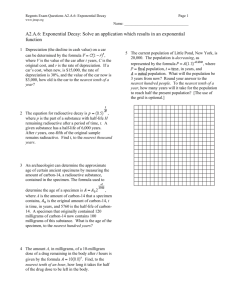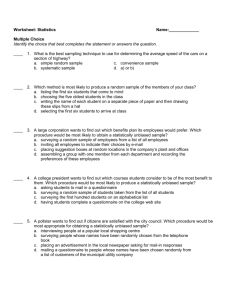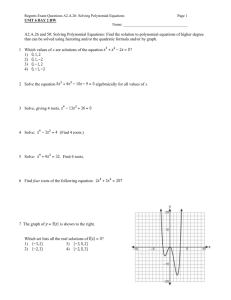your - College of Health & Human Services
advertisement
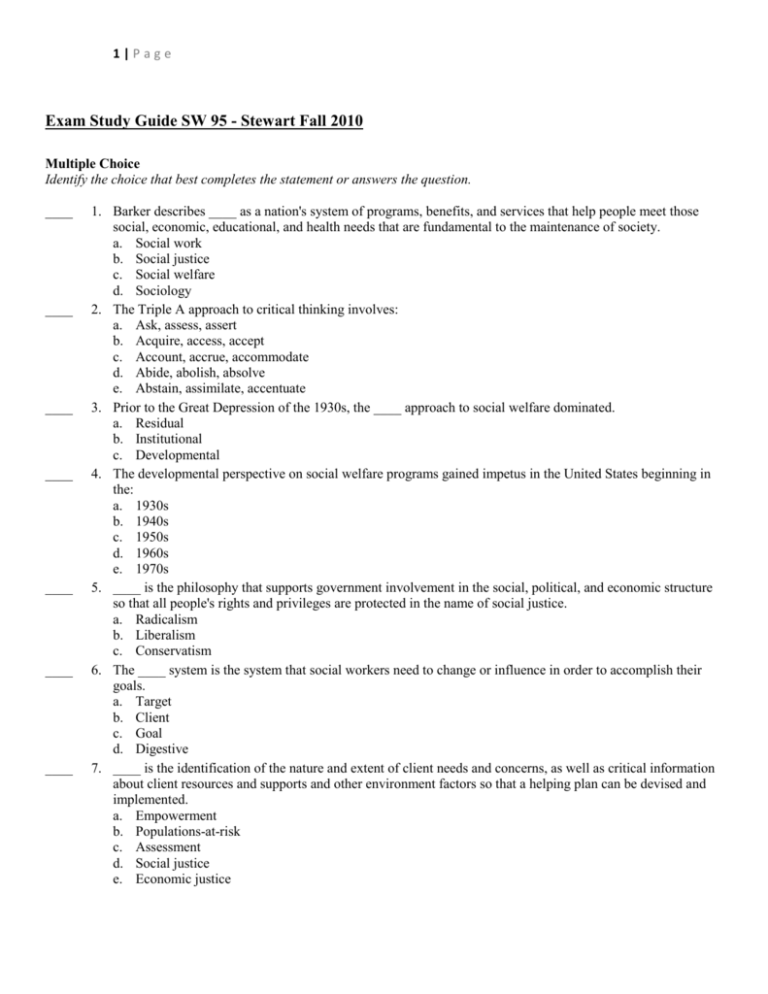
1|Page Exam Study Guide SW 95 - Stewart Fall 2010 Multiple Choice Identify the choice that best completes the statement or answers the question. ____ ____ ____ ____ ____ ____ ____ 1. Barker describes ____ as a nation's system of programs, benefits, and services that help people meet those social, economic, educational, and health needs that are fundamental to the maintenance of society. a. Social work b. Social justice c. Social welfare d. Sociology 2. The Triple A approach to critical thinking involves: a. Ask, assess, assert b. Acquire, access, accept c. Account, accrue, accommodate d. Abide, abolish, absolve e. Abstain, assimilate, accentuate 3. Prior to the Great Depression of the 1930s, the ____ approach to social welfare dominated. a. Residual b. Institutional c. Developmental 4. The developmental perspective on social welfare programs gained impetus in the United States beginning in the: a. 1930s b. 1940s c. 1950s d. 1960s e. 1970s 5. ____ is the philosophy that supports government involvement in the social, political, and economic structure so that all people's rights and privileges are protected in the name of social justice. a. Radicalism b. Liberalism c. Conservatism 6. The ____ system is the system that social workers need to change or influence in order to accomplish their goals. a. Target b. Client c. Goal d. Digestive 7. ____ is the identification of the nature and extent of client needs and concerns, as well as critical information about client resources and supports and other environment factors so that a helping plan can be devised and implemented. a. Empowerment b. Populations-at-risk c. Assessment d. Social justice e. Economic justice 2|Page ____ ____ ____ ____ ____ ____ ____ 8. "Providing help, resources, and benefits so people can achieve their maximum potential" is the definition of the NASW Code of Ethics' core value of: a. Social justice b. Integrity c. Service d. Importance of human relations e. Competence 9. "Having the necessary skills and abilities to effectively perform work with clients" describes the ____ core value of the NASW Code of Ethics. a. Social justice b. Competence c. Service d. Integrity e. Dignity and warmth of the person 10. "Maintaining trustworthiness and sound adherence to moral ideals" describes the ____ value of the NASW Code of Ethics. a. Integrity b. Social justice c. Dignity and warmth of the person d. Service e. Competence 11. According to the NASW Code of Ethics, which of the following is (are) considered a social worker's ethical responsibility to colleagues: a. Informed consent b. Interdisciplinary collaboration c. Integrity of the profession d. Public participation e. Billing 12. According to the NASW Code of Ethics, client ____ is the condition of being free from unauthorized observation or intrusion. a. Privacy b. Confidentiality c. Compliance d. Self Determination e. Transition 13. In the text, Internet ethics is called: a. Netethics b. Interethics c. Netiquette d. Ethicalnetworks e. Nethics 14. ____ is the process of global integration in which diverse peoples, economies, cultures, and political processes are increasingly subjected to international influences. a. Economic infusion b. Cultural competence c. Worldview d. Globalization 3|Page ____ 15. ____ is the transfer of people across international boundaries to enslave them in some way, usually involving forced labor or sexual exploitation. a. Illegal immigration b. Human trafficking c. Human harvesting d. Alien abducting ____ 16. Which of the following is true: a. Social workers must learn to get rid of all their personal values to be an effective generalist practitioner b. The principle of self-determination allows the practitioner to bend the client towards the worker's values c. If a social worker strongly believes that a client's religious beliefs could be a detriment to the client, the worker must change the client's beliefs d. None of the above are true ____ 17. ____ is an opinion about an individual, group, or issue that is not based on fact. a. Discrimination b. Prejudice c. Stereotype d. Oppression ____ 18. ____ is the ability of an individual, family, group, community, or organization to recover from adversity and resume functioning even when suffering serious trouble, confusion, or hardship. a. Resiliency b. Strengths perspective c. Empowerment d. Self-fulfilling prophecy ____ 19. Resiliency involves which of the following factors: a. Vulnerability b. Risk c. Commonality d. Safety ____ 20. ____ refers to a member of a group of people who, because of physical or cultural characteristics, are singled out from the others in the society in which they live for differential and unequal treatment, and who therefore regard themselves as objects of collective discrimination. a. Race b. Minority c. People of color d. Ethnicity ____ 21. ____ refers to the affiliation with a large group of people who have common racial, national, tribal, religious, linguistic, or cultural origin or background. a. Race b. Minority c. People of color d. Ethnicity ____ 22. Women in management, business, and financial occupations earn a median full-time salary of about ____ percent of what men earn. a. 61 b. 71 c. 81 4|Page ____ 23. ____ 24. ____ 25. ____ 26. ____ 27. ____ 28. ____ 29. ____ 30. ____ 31. d. 91 Among some Mexican Americans and other Central and South Americans, ____ are healers who use a range of treatments, such as herbal remedies, inhalation, sweating, massage, incantations, and a ritual cleansing. a. Marianismos/as b. Curanderos/as c. Limpiezos/as d. Compadres The word Islam is derived from the Arabic word meaning: a. God b. Holy c. Peace d. Prayer The ____ resolves arguments or disagreements among micro, mezzo, or macro systems in conflict. a. Facilitator b. Advocate c. Mediator d. Educator e. Mobilizer The ____ guides a group experience. a. Facilitator b. Educator c. Advocate d. Educator e. Mobilizer The Triple A approach to critical thinking is: a. Apprehend, Accept, Administer b. Agree, Assert, Accept c. Ask, Assess, Assert d. Acclaim, Accept, Absolve The text cites several fallacies that can trick people into false beliefs. Which of the following is (are) included: a. Being vague b. Relying on case examples c. Being biased or unobjective d. All of the above e. a and c only Another term that generalist practitioners often use instead of the planned-change process is: a. Suggested path b. Problem solving c. Situational assessment d. Crisis contemplation e. Deductive reasoning ____ involves not only being in tune with how clients feel but also conveying to them that workers understand how they feel. a. Empathy b. Genuineness c. Warmth The ____ stage of an intervention specifies what should be done. a. Planning 5|Page ____ 32. ____ 33. ____ 34. ____ 35. ____ 36. ____ 37. ____ 38. ____ 39. ____ 40. b. Assessment c. Evaluation d. Engagement e. Implementation Which of the following is true about cultural differences in nonverbal and verbal communication: a. African Americans may maintain eye contact more when listening and slightly less when talking b. In Japan smiling may indicate discomfort c. Many Latin people often prefer greater distance than North Americans when talking ____ communities are based on some commonality other than location. a. Locality based b. Nongeographic c. Common d. Disparate In a(n) ____ role, a social worker might teach an abusive parent effective child management techniques. a. Broker b. Educator c. Case manager d. Counselor ____ support involves help such as money, rides, and shelter. a. Appraisal b. Instrumental c. Informational ____ groups are aimed at expanding self-awareness, increasing potential, and maximizing health and wellbeing. a. Therapy b. Support c. Socialization d. Growth e. Educational The idea of the method of community organization called ____ is to involve as many people as possible within the community in a democratic manner to define their goals and help themselves. a. Social planning b. Social action c. Locality development A group of agency workers and clients who join forces to conduct a letter-writing campaign to legislators to place stoplights at a dangerous intersection is an example of a(n): a. Social action group b. Treatment conference c. Administrative group d. Committee ____ is a group of representatives from various agencies or from units within a single agency that meet to discuss issues of mutual concern. a. Delegate council b. Administrative group c. Treatment conference Social work in rural communities: a. Is not nearly as generalist as in urban social work 6|Page ____ 41. ____ 42. ____ 43. ____ 44. ____ 45. ____ 46. ____ 47. ____ 48. ____ 49. b. Requires that dual or multiple relationships are to be avoided at all costs c. Involves working with natural helping networks The greatest number of social workers with a bachelor's degree at graduation are employed in which of the following field of practice: a. Youth services b. Crisis intervention c. Mental/behavioral health d. Corrections/criminal justice The greatest number of social workers 2 years post graduation with a bachelor's degree are employed in which of the following fields of practice: a. Youth services b. Alcohol, drug, or substance abuse c. Child welfare/child protective services d. School social work The majority of social workers with master's degrees are employed in which of the following fields of practice: a. Youth services b. Mental/behavioral health c. School social work d. Family services The majority of BSW alumni felt their first major role was: a. Case management b. Advocacy c. Counseling d. Brokering After feudalism's demise in Europe: a. People fled the urban areas looking for work in the rural areas b. Cholera destroyed almost a third of the English population c. A law was passed restricting the unemployed from moving about d. A law was passed forbidding impotent poor from begging The ____ was considered the first piece of legislation establishing coherent, consistent public support for needy people through local taxes. a. Statute of Laborers b. Law of Settlement c. Social Welfare Act d. Begger Tax e. Elizabethan Poor Law The English Elizabethan Poor Law was established in: a. 1345 b. 1592 c. 1601 d. 1773 ____ were institutions in England where the impotent poor were placed and provided food and shelter. a. Welfare shelters b. Missions c. Speenhamlands d. Almshouses Which of the following is (are) true regarding the early poor laws in the American colonies: 7|Page ____ 50. ____ 51. ____ 52. ____ 53. ____ 54. ____ 55. ____ 56. a. Resembled or were identical to those in England b. Colonists viewed the poor as a natural part of the social order c. Services reflected a mix of public and private collaboration d. All of the above e. a and c only The Civil War occurred from: a. 1780-1785 b. 1801-1802 c. 1861-1865 d. 1890-1891 ____ began a settlement house in Chicago called the Hull House: a. Mary Richmond b. Jane Addams c. Dorothea Dix d. Etta Wheeler The ____ initially recruited males between 18 and 25 who were receiving public assistance, and transported them to revitalize parks in the West. a. The Public Works Administration b. The Civilian Works Administration c. The Civilian Conservation Corps d. The Works Progress Administration e. The Federal Emergency Relief Act The ____ supported the work of artists, musicians, writers, and scholarsprovided jobs from heavy construction to the painting of murals in local libraries and orchestral performances in the schools. a. The Public Works Administration b. The Civilian Works Administration c. The Civilian Conservation Corps d. The Works Progress Administration e. The Federal Emergency Relief Act ____ provided old-age insurance (pensions) for older adults; unemployment insurance; and worker's compensation. a. Public assistance b. Social insurance c. Dependent children assistance d. Older Americans Act ____ provided preschoolers with resources designed to meet educational, health, and recreational needs through the year. a. Operation Head Start b. Job Corps c. Volunteers in Service to America d. Upward Bound e. Community Action Program ____ developed and coordinated efforts by neighborhood organizations to fight poverty and improve social and economic conditions for community residents. a. Operation Head Start b. Job Corps c. Volunteers in Service to America d. Upward Bound 8|Page ____ 57. ____ 58. ____ 59. ____ 60. ____ 61. ____ 62. ____ 63. ____ 64. ____ 65. e. Community Action Program ____ targeted school-age children and presented them with special education resources and incentives to prevent them from dropping out of school. a. Operation Head Start b. Job Corps c. Volunteers in Service to America d. Upward Bound e. Community Action Program ____ involves volunteers recruited to work in urban and rural neighborhoods experiencing economic and cultural problems. a. Operation Head Start b. Job Corps c. Volunteers in Service to America d. Upward Bound e. Community Action Program Which of the following is (are) true regarding American Indian history: a. During initial European colonization there were an estimated 120 different nations b. The first treaty was with the Sioux nation c. Congress ceased making treaties with nations in 1981 d. The federal Bureau of Indian Affairs was established in 1890 The Bureau of Refugees, Freedmen, and Abandoned Land was more commonly known as the: a. Slave Organization b. Underground Railroad c. Lincoln's Folly d. Freedmen's Bureau The ____ in 1917 gave all people born on the island of Puerto Rico U.S. citizenship. a. Puerto Rican Territorial Treaty b. Jones Act c. Island Territory Settlement d. Immigration and Citizenship Act Cesar Chavez formed the: a. Community Service Organization b. United Grape Growers c. Agricultural Consortium d. California Migrant Worker Society e. National Farm Workers Association The mental hygiene movement occurred in the United States from: a. 1770s-1900 b. 1900-1945 c. Early 1950s to present The Reverend Charles Loring Brace: a. Was the founder of the Settlement House in Chicago, Illinois b. Gathered up thousands of juvenile paupers from the New York City streets and sent them to live with farm families in the Midwest c. Believed that farmers were the ideal citizens and that farming was the ideal occupation d. All of the above e. b and c only The ____ was the beginning of moral treatment movement in mental health. 9|Page ____ 66. ____ 67. ____ 68. ____ 69. ____ 70. ____ 71. ____ 72. ____ 73. a. 1600s b. 1770s c. 1950s d. 1960s e. 1990s In ____, the Civil Rights Act was passed. a. 1601 b. 1770 c. 1954 d. 1964 e. 1996 The Social Security Act was passed in: a. 1300 b. 1865 c. 1929 d. 1935 e. 1990 The final phase in the process of social welfare policy development is: a. Formulation of social welfare policy b. Agency service delivery c. Implementation through a social welfare program d. Identification of public opinion The fifth phase of social welfare policy development involves: a. Identification of problems and needs b. Formulation of social welfare policy c. Identification of public opinion d. Implementation through a social welfare program Food stamps, free school lunches, and rent subsidies are considered ____ benefits provided to eligible clients. a. In-kind b. Incognito c. In-need d. Initial Which of the following would be considered a personal social service: a. Rent subsidies b. Food stamps c. Counseling d. Cash e. Day care The primary principle involved in ____ is that the system requires a major overhaul to achieve more appropriate goals. a. Radicalism b. Conservatism c. Liberalism ____ believe that the government should not interfere unless absolutely necessary. a. Radicalism b. Conservatism c. Liberalism 10 | P a g e ____ 74. Condy and Hily are two women who are currently residing at the Loving Arms homeless shelter. They begin a discussion about the state of social welfare programs in the country when Hily says "It is society's obligation to assist people in adjusting to the turbulent and demanding contemporary environment." Condy nods her head and says, "You go, girl! You sure are talking like a ____:" a. Liberal b. Conservative ____ 75. Basic concepts inherent in the residual perspective on social welfare policy and program development include: a. Social welfare policies and programs should be reactive, solving problems only after they occur b. Social welfare policies and programs serve to relieve existing tensions and help solve problems distressing people in their environment c. Social welfare policies and programs should provide ongoing support to all people in need d. All of the above e. None of the above ____ 76. ____ coincides somewhat with the residual perspective on social welfare. a. Selectivity b. Universality ____ 77. ____ are individuals who are hired to attempt to influence legislators' decisions and votes through direct communication. a. Influencers b. Irritators c. Campaign managers d. Lobbyists ____ 78. According to the Census Bureau, ____ million people are poor in the United States. a. 3 b. 10 c. 37 d. 53 ____ 79. According to Kornblum & Julian, ____ of the 6.4 billion people on Earth are so poverty-stricken that they must survive on $1 per day or less. a. 5.3 million b. 10.8 million c. 98.2 million d. 1.2 billion e. 4 billion ____ 80. The median income of female-headed families is about ____% of the median for families with two parents present. a. 21 b. 31 c. 41 d. 51 ____ 81. ____ is the tendency to divide the population into categories of social position based on the extent to which people have access to the goods and services the society values. a. Societal division b. Social stratification c. Class arrangement d. Caste system 11 | P a g e ____ 82. Which of the following would be considered an economic explanation for poverty: a. The increasing trend for industries to move from North America to other parts of the world where production costs are cheaper b. Racial segregation in communities often results in the concentration of people of color in poor urban environments c. Decreasing levels of financial assistance, resources, and services available ____ 83. OASDHI covers ____ percent of all workers in the United States. a. 45 b. 55 c. 75 d. 95 ____ 84. ____ was created by the Health Insurance for the Aged Act, and consists of Part A, B, C, & D. a. Medicare b. Medicaid c. Supplemental Security Income d. General Assistance ____ 85. Which of the following is (are) true regarding Temporary Assistance to Needy Families (TANF): a. Is a grant program through the Personal Responsibility and Work Opportunity Reconciliation Act b. Decreases the states' discretion over benefit distribution c. Allows mothers with children age 6 or older to receive benefits, and allows them to stay home and care for their children d. All of the above e. None of the above ____ 86. Single parents receiving TANF assistance are required to work at least ____ hours per week depending on their situation. a. 15 b. 20 c. 25 d. 30 e. 35 ____ 87. Which of the following is true: a. The public assistance caseload has been constantly expanding b. Welfare recipients are mainly African Americans c. Public assistance cost the nation a fortune d. None of the above is true ____ 88. On the continuum of need for families' survival, one end involves basic financial and material resources all families need to survive. Which one of the following represents the opposite end of the continuum: a. Moderate supportive services b. Substitute services c. Extensive supportive services d. Limited supportive services ____ 89. ____ is the umbrella term for physical abuse, sexual abuse, emotional abuse and neglect. a. Child protective services b. Family life education c. Intensive family preservation d. Child maltreatment e. Child abuse 12 | P a g e ____ 90. Which of the following would be considered emotional/psychological maltreatment: a. Extreme public embarrassment b. Urging or forcing a child into delinquent behavior c. Lacking appropriate winter clothing in a cold climate d. All of the above e. a and b only ____ 91. The majority of child maltreatment results from: a. Physical abuse b. Emotional maltreatment c. Sexual abuse d. Neglect ____ 92. ____ provides children the opportunity to form a special relationship with a supportive adult role model. a. Big Brother/Big Sister b. Day care c. Respite care d. Parental aides ____ 93. ____ is a program that offers temporary provision of care so parents have some time away from child responsibilities. a. Big Brother/Big Sister b. Day care c. Respite care d. Parental aides ____ 94. ____ involves taking an active, directive role on behalf of a client or client group in need of help. a. Referral b. Brokering c. Advocacy ____ 95. ____ is a comprehensive care planning process directed toward the goal of a permanent, stable home for a child placed in substitute care. a. Goal development b. Home placement c. Kinship care d. Permanency planning ____ 96. ____ homes offer an ongoing residence for children unable to return to their parents' home but unadoptable for various reasons. a. Specialized foster b. Shelter c. Long-term foster d. Treatment foster care ____ 97. Of the older adults living in the United States, ____ percent would fall below the poverty line if they were not receiving Social Security benefits. a. 30 b. 50 c. 75 d. 90 ____ 98. By 2022, people will be able to receive full Social Security benefits at age: a. 62 b. 65 c. 67 13 | P a g e ____ 99. ____ 100. ____ 101. ____ 102. ____ 103. ____ 104. ____ 105. ____ 106. ____ 107. d. 70 ____ is a concept of empowerment that emphasizes how people can use their strengths to survive, accept new experiences, and learn to appreciate the positive aspects of these new experiences. a. Competence b. Adaptation c. Relatedness d. Autonomy Written instructions by an individual who is mentally competent to health care providers and family members about end-of-life decisions are called: a. Wills b. Durable power of attorney for health care c. Advanced directives d. Social histories Traditional Navajo people believe which of the following: a. They prefer to die in their own homes b. Members of the family of the dead person must dress them for burial c. Most Grandparents have prepared living wills d. They want to avoid having death occur in the hogan ____ of retirees depend on Social Security as a major source of income. a. One-third b. One-half c. Two-thirds d. Three-fourths ____ is a disease affecting voluntary muscles (those controlled by one's will) in which nerve impulses are impaired, resulting in fatigue, weakness, and difficulties controlling muscles. a. Muscular dystrophy b. Myasthenia gravis c. Rheumatoid arthritis d. Multiple sclerosis e. Stroke ____ is the belief that every person, even those with the most severe disabilities, should have an educational and living environment as close to normal as possible. a. Deinstitutionalization b. Educational equivalency c. Normalization d. Equality in education Treatment of people with developmental disabilities during the 1970s and 1980s involved: a. A community-based approach b. Emphasis on individual pathology c. A consumer empowerment model ____ is a federal program that provides uniform cash assistance to the needy, blind, aged, and disabled throughout the country. a. Pratt-Smoot Act of 1931 b. Randolph-Sheppard Act of 1930 c. Supplemental Security Income d. Rehabilitation Act of 1973 and 1992 amendments The federal government now has ____ percent fewer employees with severe disabilities than it did 10 years ago. 14 | P a g e ____ 108. ____ 109. ____ 110. ____ 111. ____ 112. ____ 113. ____ 114. a. 20 b. 30 c. 40 d. 50 Organizations that provide a wide range of health-care services for participants and employers who typically pay an established monthly fee for services are called: a. HMOs b. PYOs c. MHAs d. BYOs Which of the following issues was (were) listed in the text as plaguing the U.S. health care system today: a. Unequal access to health care b. Escalating cost of health care c. Cultural competence d. All of the above e. a and b only Which of the following is (are) true about health care in the United States: a. Technology is decreasing in the health care field b. Administrative overhead for running health-care organizations is slowly decreasing c. Administrative overhead is the highest in the world d. All of the above e. None of the above ____ is described in the text as a publicly-funded program that would expand the current system of healthcare provision to provide some level of coverage to everyone regardless of their ability to pay. a. Consistent care b. Government subsidy c. Guaranteed coverage d. National health insurance Which of the following was (were) listed in the text as a specific provision(s) to improve legislation to protect clients and their rights: a. Guarantee patients the right to choose a doctor outside their health plans' networks if they agree to share the cost of services b. Require companies to set up procedures under which providers could appeal denials of coverage c. Ensure patients access to detailed information about coverage and treatment options d. All of the above e. a and b only ____ is described in the text as the efficient ongoing provision of services by different or the same agencies to meet clients' needs as their circumstances and needs change. a. Continuity of care b. Guaranteed coverage c. Steady service provision d. Circumstantial endurance ____ is the conception that events are fixed in advance so that human beings are powerless to change them. a. Filial piety b. Fatalism c. Synergism d. Stasis 15 | P a g e ____ 115. The specific type of T cell that is vulnerable to HIV is the ____ cell. a. TX4 b. HAART c. R2D2 d. CD4 T ____ 116. Which of the following is (are) true: a. HIV can be transmitted by having sexual intercourse with an HIV-positive partner b. Babies cannot contract AIDS before birth from their infected mothers c. AIDS can be transmitted by mosquitoes d. All of the above e. None of the above ____ 117. ____ percent of the world's children who have HIV/AIDS live in Sub-Saharan Africa. a. 68 b. 78 c. 88 d. 98 ____ 118. Samantha is a staff member in a residential treatment center. Samantha says to Billy (a resident), "Hey, Billy, you really did a nice job completing your chores this week. Way to go!" Samantha is attempting a procedure called ____, hoping that this will increase the frequency of Billy doing his chores on time. a. Channeling b. Coercive training c. Positive reinforcement d. Affirmation modeling ____ 119. ____ is the process of giving people information, positive or negative, about their performance or behavior. a. Regurgitation b. Feedback c. Input/Output d. Circuitry ____ 120. ____ is any number of serious mental disorders characterized by disturbed, inappropriate behavior and loss of contact with reality. a. Schizophrenia b. Psychosis c. Dementia d. Neurosis ____ 121. ____ disorders involve a disruption in the usually integrated functions of consciousness, memory, identity, or perception:. a. Dissociative b. Anxiety c. Depressive d. Bipolar ____ 122. Which of the following is true regarding electroconvulsive therapy (ECT): a. Approximately 1,000 Americans are treated with electroconvulsive therapy each year b. In 1820, two Germans were the first to actually use an electrical current to treat a schizophrenic man experiencing severe hallucinations c. ECT is not considered long-term protection against suicide, but rather a short-term treatment for acute illness d. Of persons receiving ECT, 20-25 percent improve after treatment ____ 123. ____ is a term referring to dependence on some substance. 16 | P a g e ____ 124. ____ 125. ____ 126. ____ 127. ____ 128. ____ 129. ____ 130. ____ 131. ____ 132. a. Tolerance b. Addiction c. Intoxication d. Alcoholism The method of substance administration that takes the most time to take affect is: a. Oral ingestion b. Inhalation c. Injection d. Mucous membrane The use of ____ is responsible for more than 400,000 deaths in the United States each year. a. Nicotine b. Heroin c. Valium d. Barbiturates Opioids include all of the following except: a. Heroin b. Cocaine c. Opium d. Morphine ____ is the defense mechanism used by people with alcohol problems by assigning little importance to drinking or its consequences. a. Minimization b. Rationalization c. Denial ____ is the defense mechanism that involves making excuses for the problems caused by the dependence on the substance. a. Minimization b. Rationalization c. Denial The most prevalent defense used by people who are substance dependent is: a. Minimization b. Rationalization c. Denial ____ are residential programs where clients remain for one to three years, although some require only a 6month stay with the intent to immerse clients in an environment aimed at a global change in lifestyle. a. Therapeutic communities b. Halfway houses c. Inpatient treatment facilities d. Mutual self-help groups ____ strategies for alcohol or other drug misuse are based on the premise that alcohol or other drug use ranges across a continuum, starting with no consequences for use and ending with devastating consequences for use, with lots of stages in between. a. Four-stage recovery b. Therapeutic adjunct c. Behavior continuance d. Harm reduction A ____ is a person who suggests, guides, eases, or expedites the way for others during a group experience. a. Facilitator 17 | P a g e ____ 133. ____ 134. ____ 135. ____ 136. ____ 137. ____ 138. ____ 139. ____ 140. b. Community Intervention Collaborator c. Policy Initiator and Developer d. Counselor A ____ is a person who works with others in the community to initiate change or develop needed programs. a. Facilitator b. Community Intervention Collaborator c. Policy Initiator and Developer d. Counselor Setting up a group for trauma-related recovery is considered ____ practice. a. Mezzo b. Micro c. Macro The process of a person acknowledging that he or she is lesbian, gay, or bisexual is called: a. LGB declaration b. Coming out c. Sex announcement d. Walking in Step 3 of the coming-out process involves: a. Coming out to oneself b. Being open to the world about being gay or lesbian c. Taking the risk of sharing the self-identity with people who are close to them d. Seeking out other LGBT people and learning about what is means to be gay Which of the following is (are) true: a. Lesbians and gay men are obviously homosexual based on how they look and dress b. Gay men are child molesters c. Lesbian and gay people in couples like to assume traditional gender-role stereotypes d. All of the above e. None of the above Which of the following is (are) true about the community project described in the text: a. The agency is called New Connections b. The agency was established by a Center on Substance Abuse Prevention grant c. The purpose of the agency was to identify and recruit community resources to find home placements for people with Alzheimer's disease d. All of the above e. None of the above Which of the following is (are) true about the community project described in the text: a. Nuevo Puente hired six girls and four boys to conduct a community strengths assessment of a 40-block urban community b. Nuevo Puente provided cultural and educational activities for at-risk youths c. Nuevo Puente provided training to carry out school and community education on alcohol, tobacco, and other drugs d. All of the above e. a and c only ____ was described in the text as the scientific description of a culture. a. Cultural analysis b. Cultural anthropology c. Ethnographic study d. Human comparative study 18 | P a g e ____ 141. Which of the following is (are) true about the example in the text of how social workers helped to empower African American youth: a. It was a study about mobilizing a school community in Mississippi b. The study targeted African American youths belonging to the Church of Latter Day Saints c. Of special concern were the perceived negative expectations of white educators in the public school system d. All of the above e. None of the above ____ 142. Which of the following were listed in the text as early warning signs for school violence potential: a. Social withdrawal b. Being a victim of violence c. Excessive feelings of rejection d. All of the above e. a and b only ____ 143. Social workers may assume which of the following goals when providing services to adolescents concerning pregnancy and parenting: a. Prevention of pregnancy b. Identification of pregnancy c. Counseling concerning alternatives d. All of the above e. a and b only ____ 144. A ____ value orientation might emphasize that it is parents' responsibility to provide information about sex to their children and that schools should not interfere with parental prerogative. a. Conservative b. Liberal c. Progressive d. Institutional ____ 145. ____ involves restoring a person to a state of productive, noncriminal functioning in society. a. Rehabilitation b. Adjudication c. Incarceration d. Incapacitation ____ 146. The act of attacking another person with the intent to inflict serious harm or kill that person is called: a. Larceny b. Robbery c. Burglary d. Aggravated assault ____ 147. The act of stealing property is called: a. Larceny b. Robbery c. Burglary d. Aggravated assault ____ 148. The crime rate for female adolescents has increased by ____ percent. a. 4 b. 14 c. 24 d. 34 ____ 149. ____ is described as the practice of targeting suspects on the basis of race. 19 | P a g e a. Status offense b. Racial profiling c. Ethnic coercion d. Color blind ____ 150. The Afrocentric approach rests on all of the following principles except: a. Ethnocentricity b. Collective work and responsibility c. Creativity d. Purpose 20 | P a g e Exam Study Guide SW 95 Fall 2010 Answer Section MULTIPLE CHOICE 1. ANS: MSC: 2. ANS: MSC: 3. ANS: 4. ANS: 5. ANS: 6. ANS: MSC: 7. ANS: 8. ANS: 9. ANS: MSC: 10. ANS: 11. ANS: 12. ANS: 13. ANS: 14. ANS: 15. ANS: 16. ANS: 17. ANS: 18. ANS: MSC: 19. ANS: 20. ANS: 21. ANS: 22. ANS: 23. ANS: 24. ANS: MSC: 25. ANS: 26. ANS: 27. ANS: MSC: 28. ANS: 29. ANS: 30. ANS: 31. ANS: 32. ANS: 33. ANS: C w A w A E B A w C C B w A B A C D B D B A w B B D B B C w C A C w D B A A B B PTS: 1 REF: pg. 6 OBJ: 1.A PTS: 1 REF: pg. 7 OBJ: 1.B PTS: PTS: PTS: PTS: REF: REF: REF: REF: OBJ: OBJ: OBJ: OBJ: 1 1 1 1 pg. 8 pg. 8 pg. 10 pg. 20 1.C 1.C 1.D 1.J PTS: 1 PTS: 1 PTS: 1 REF: pg. 24 REF: pg. 31 REF: pg. 32 OBJ: 1.K OBJ: 2.A OBJ: 2.A PTS: PTS: PTS: PTS: PTS: PTS: PTS: PTS: PTS: 1 1 1 1 1 1 1 1 1 REF: REF: REF: REF: REF: REF: REF: REF: REF: pg. 32 pg. 34 pg. 35 pg. 36 pg. 42 pg. 43 pg. 47 pg. 53 pg. 55 OBJ: OBJ: OBJ: OBJ: OBJ: OBJ: OBJ: OBJ: OBJ: 2.A 2.B 2.B 2.D 2.F 2.G 2.H 3.A 3.E PTS: PTS: PTS: PTS: PTS: PTS: 1 1 1 1 1 1 REF: REF: REF: REF: REF: REF: pg. 55 pg. 58 pg. 58 pg. 72 pg. 63 pg. 82 OBJ: OBJ: OBJ: OBJ: OBJ: OBJ: 3.E 3.F 3.F 3.G 3.I 3.K PTS: 1 PTS: 1 PTS: 1 REF: pg. 95 REF: pg. 96 REF: pg. 97 OBJ: 4.A OBJ: 4.A OBJ: 4.B PTS: PTS: PTS: PTS: PTS: PTS: REF: REF: REF: REF: REF: REF: OBJ: OBJ: OBJ: OBJ: OBJ: OBJ: 1 1 1 1 1 1 pg. 97-98 pg. 98 pg. 102 pg. 104 pg. 103 pg. 113 4.B 4.C 4.C 4.C 4.D 5.A 21 | P a g e 34. 35. 36. 37. 38. 39. 40. 41. 42. 43. 44. 45. 46. 47. 48. 49. 50. 51. 52. 53. 54. 55. 56. 57. 58. 59. 60. 61. 62. 63. 64. 65. 66. 67. 68. 69. 70. 71. 72. 73. 74. 75. 76. ANS: ANS: ANS: ANS: ANS: ANS: ANS: ANS: ANS: ANS: ANS: ANS: ANS: ANS: ANS: ANS: ANS: ANS: ANS: ANS: ANS: ANS: ANS: ANS: ANS: ANS: MSC: ANS: MSC: ANS: ANS: ANS: ANS: ANS: ANS: ANS: ANS: ANS: MSC: ANS: ANS: ANS: ANS: ANS: ANS: ANS: B B D C A A C D C B A C E C D D C B C D B A E D C C w D w B E B E B D D B D w A C A B A A A PTS: PTS: PTS: PTS: PTS: PTS: PTS: PTS: PTS: PTS: PTS: PTS: PTS: PTS: PTS: PTS: PTS: PTS: PTS: PTS: PTS: PTS: PTS: PTS: PTS: PTS: 1 1 1 1 1 1 1 1 1 1 1 1 1 1 1 1 1 1 1 1 1 1 1 1 1 1 REF: REF: REF: REF: REF: REF: REF: REF: REF: REF: REF: REF: REF: REF: REF: REF: REF: REF: REF: REF: REF: REF: REF: REF: REF: REF: pg. 117 pg. 119 pg. 122 pg. 122 pg. 124 pg. 124 pg. 115 pg. 129 pg. 129 pg. 129 pg. 132 pg. 146 pg. 146 pg. 146 pg. 146 pg. 147 pg. 151 pg. 154 pg. 160 pg. 160 pg. 161 pg. 165 pg. 165 pg. 165 pg. 165 pg. 149 OBJ: OBJ: OBJ: OBJ: OBJ: OBJ: OBJ: OBJ: OBJ: OBJ: OBJ: OBJ: OBJ: OBJ: OBJ: OBJ: OBJ: OBJ: OBJ: OBJ: OBJ: OBJ: OBJ: OBJ: OBJ: OBJ: 5.B 5.B 5.B 5.B 5.B 5.B 5.C 5.G 5.G 5.G 5.G 6.A 6.A 6.A 6.A 6.B 6.B 6.B 6.B 6.B 6.B 6.B 6.B 6.B 6.B 6.C PTS: 1 REF: pg. 151 OBJ: 6.C PTS: PTS: PTS: PTS: PTS: PTS: PTS: PTS: PTS: 1 1 1 1 1 1 1 1 1 REF: REF: REF: REF: REF: REF: REF: REF: REF: pg. 159 pg. 167 pg. 149 pg. 152 pg. 178 pg. 179 pg. 178 pg. 186 pg. 189 OBJ: OBJ: OBJ: OBJ: OBJ: OBJ: OBJ: OBJ: OBJ: 6.C 6.C 6.D 6.D 6.F 6.F 6.F 7.A 7.B PTS: PTS: PTS: PTS: PTS: PTS: PTS: 1 1 1 1 1 1 1 REF: REF: REF: REF: REF: REF: REF: pg. 191 pg. 191 pg. 193 pg. 193 pg. 193 pg. 194 pg. 195 OBJ: OBJ: OBJ: OBJ: OBJ: OBJ: OBJ: 7.C 7.C 7.D 7.D 7.D 7.D 7.D 22 | P a g e 77. 78. 79. 80. 81. 82. 83. 84. 85. 86. 87. 88. 89. 90. 91. 92. 93. 94. 95. 96. 97. 98. 99. 100. 101. 102. 103. 104. 105. 106. 107. 108. 109. 110. 111. 112. 113. 114. 115. 116. 117. ANS: ANS: ANS: ANS: ANS: MSC: ANS: ANS: ANS: ANS: ANS: ANS: ANS: MSC: ANS: ANS: ANS: MSC: ANS: ANS: ANS: ANS: ANS: ANS: ANS: ANS: ANS: ANS: ANS: ANS: ANS: MSC: ANS: ANS: ANS: ANS: ANS: ANS: ANS: ANS: ANS: MSC: ANS: ANS: ANS: ANS: D C D C B w A D A A D D B w D E D w A C C D C B C B C D C B C w A C A A D C D D A w B D A C PTS: PTS: PTS: PTS: PTS: 1 1 1 1 1 REF: REF: REF: REF: REF: pg. 200 pg. 203 pg. 205 pg. 206 pg. 208 OBJ: OBJ: OBJ: OBJ: OBJ: 7.F 8.A 8.A 8.B 8.C PTS: PTS: PTS: PTS: PTS: PTS: PTS: 1 1 1 1 1 1 1 REF: REF: REF: REF: REF: REF: REF: pg. 210 pg. 217 pg. 219 pg. 222 pg. 223 pg. 227 pg. 243 OBJ: OBJ: OBJ: OBJ: OBJ: OBJ: OBJ: 8.D 8.G 8.G 8.G 8.G 8.H 9.B PTS: 1 PTS: 1 PTS: 1 REF: pg. 245 REF: pg. 246 REF: pg. 248 OBJ: 9.C OBJ: 9.C OBJ: 9.C PTS: PTS: PTS: PTS: PTS: PTS: PTS: PTS: PTS: PTS: PTS: PTS: PTS: 1 1 1 1 1 1 1 1 1 1 1 1 1 REF: REF: REF: REF: REF: REF: REF: REF: REF: REF: REF: REF: REF: pg. 250 pg. 250 pg. 257 pg. 257 pg. 260 pg. 277 pg. 278 pg. 287-288 pg. 290-291 pg. 293 pg. 279 pg. 300 pg. 307 OBJ: OBJ: OBJ: OBJ: OBJ: OBJ: OBJ: OBJ: OBJ: OBJ: OBJ: OBJ: OBJ: 9.C 9.C 9.E 9.F 9.F 10.B 10.B 10.E 10.E 10.E 10.F 11.A 11.C PTS: PTS: PTS: PTS: PTS: PTS: PTS: PTS: PTS: 1 1 1 1 1 1 1 1 1 REF: REF: REF: REF: REF: REF: REF: REF: REF: pg. 307 pg. 314 pg. 312 pg. 326 pg. 326 pg. 326 pg. 327 pg. 330 pg. 330 OBJ: OBJ: OBJ: OBJ: OBJ: OBJ: OBJ: OBJ: OBJ: 11.C 11.F 11.G 12.B 12.C 12.C 12.C 12.C 12.C PTS: PTS: PTS: PTS: 1 1 1 1 REF: REF: REF: REF: pg. 332 pg. 336 pg. 337 pg. 341 OBJ: OBJ: OBJ: OBJ: 12.D 12.E 12.E 12.F 23 | P a g e 118. 119. 120. 121. 122. 123. 124. 125. 126. 127. 128. 129. 130. 131. 132. 133. 134. 135. 136. 137. 138. 139. 140. 141. 142. 143. 144. 145. 146. 147. 148. 149. 150. MSC: ANS: ANS: ANS: ANS: ANS: MSC: ANS: ANS: ANS: ANS: ANS: ANS: ANS: ANS: ANS: ANS: ANS: ANS: ANS: ANS: ANS: ANS: MSC: ANS: ANS: MSC: ANS: ANS: ANS: ANS: ANS: MSC: ANS: ANS: ANS: ANS: MSC: ANS: w C B B A C w B A A B A B C A D A B A B C E B w D C w C D D A A w D A B B w A PTS: PTS: PTS: PTS: PTS: 1 1 1 1 1 REF: REF: REF: REF: REF: pg. 350 pg. 350 pg. 355 pg. 358 pg. 366 OBJ: OBJ: OBJ: OBJ: OBJ: 13.A 13.A 13.B 13.B 13.G PTS: PTS: PTS: PTS: PTS: PTS: PTS: PTS: PTS: PTS: PTS: PTS: PTS: PTS: PTS: PTS: 1 1 1 1 1 1 1 1 1 1 1 1 1 1 1 1 REF: REF: REF: REF: REF: REF: REF: REF: REF: REF: REF: REF: REF: REF: REF: REF: pg. 383 pg. 383 pg. 384 pg. 385 pg. 386 pg. 386 pg. 386 pg. 391 pg. 393 pg. 400 pg. 402 pg. 401 pg. 405 pg. 405 pg. 407 pg. 407 OBJ: OBJ: OBJ: OBJ: OBJ: OBJ: OBJ: OBJ: OBJ: OBJ: OBJ: OBJ: OBJ: OBJ: OBJ: OBJ: 14.A 14.B 14.B 14.B 14.C 14.C 14.C 14.E 14.F 15.A 15.A 15.B 15.D 15.D 15.E 15.F PTS: 1 PTS: 1 REF: pg. 408 REF: pg. 408 OBJ: 15.F OBJ: 15.F PTS: PTS: PTS: PTS: PTS: 1 1 1 1 1 REF: REF: REF: REF: REF: pg. 408 pg. 410 pg. 416 pg. 415 pg. 422 OBJ: OBJ: OBJ: OBJ: OBJ: 15.F 15.G 15.H 15.I 16.A PTS: PTS: PTS: PTS: 1 1 1 1 REF: REF: REF: REF: pg. 423 pg. 423 pg. 424 pg. 425 OBJ: OBJ: OBJ: OBJ: 16.B 16.B 16.C 16.C PTS: 1 REF: pg. 434 OBJ: 16.G
